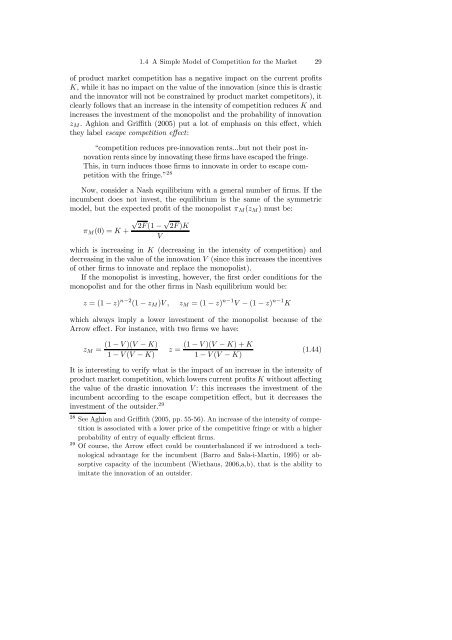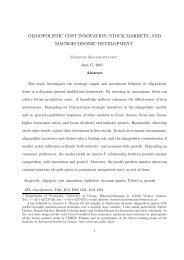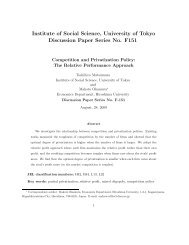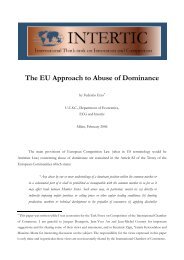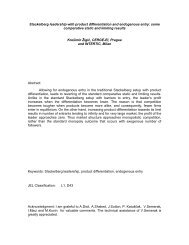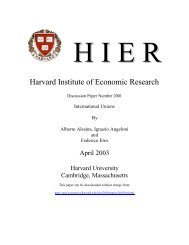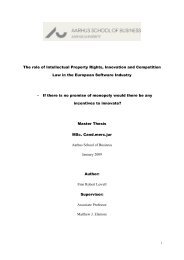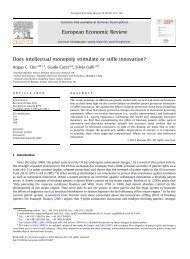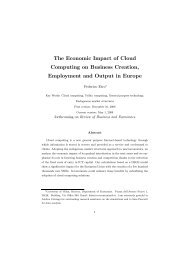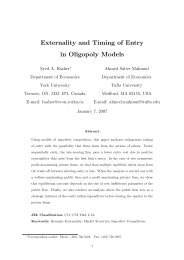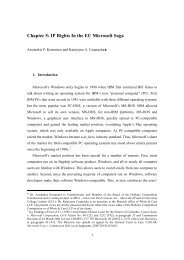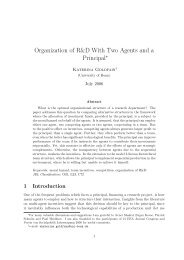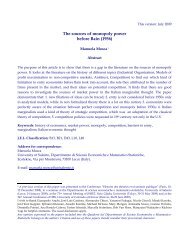Competition, Innovation, and Antitrust. A Theory of Market ... - Intertic
Competition, Innovation, and Antitrust. A Theory of Market ... - Intertic
Competition, Innovation, and Antitrust. A Theory of Market ... - Intertic
You also want an ePaper? Increase the reach of your titles
YUMPU automatically turns print PDFs into web optimized ePapers that Google loves.
1.4 A Simple Model <strong>of</strong> <strong>Competition</strong> for the <strong>Market</strong> 29<br />
<strong>of</strong> product market competition has a negative impact on the current pr<strong>of</strong>its<br />
K, while it has no impact on the value <strong>of</strong> the innovation (since this is drastic<br />
<strong>and</strong> the innovator will not be constrained by product market competitors), it<br />
clearly follows that an increase in the intensity <strong>of</strong> competition reduces K <strong>and</strong><br />
increases the investment <strong>of</strong> the monopolist <strong>and</strong> the probability <strong>of</strong> innovation<br />
z M .Aghion<strong>and</strong>Griffith (2005) put a lot <strong>of</strong> emphasis on this effect, which<br />
they label escape competition effect:<br />
“competition reduces pre-innovation rents...but not their post innovation<br />
rents since by innovating these firms have escaped the fringe.<br />
This,inturninducesthosefirms to innovate in order to escape competition<br />
with the fringe.” 28<br />
Now, consider a Nash equilibrium with a general number <strong>of</strong> firms. If the<br />
incumbent does not invest, the equilibrium is the same <strong>of</strong> the symmetric<br />
model, but the expected pr<strong>of</strong>it <strong>of</strong> the monopolist π M (z M ) must be:<br />
√ √<br />
2F (1 − 2F )K<br />
π M (0) = K +<br />
V<br />
which is increasing in K (decreasing in the intensity <strong>of</strong> competition) <strong>and</strong><br />
decreasing in the value <strong>of</strong> the innovation V (since this increases the incentives<br />
<strong>of</strong> other firms to innovate <strong>and</strong> replace the monopolist).<br />
If the monopolist is investing, however, the first order conditions for the<br />
monopolist <strong>and</strong> for the other firms in Nash equilibrium would be:<br />
z =(1− z) n−2 (1 − z M )V ,<br />
z M =(1− z) n−1 V − (1 − z) n−1 K<br />
which always imply a lower investment <strong>of</strong> the monopolist because <strong>of</strong> the<br />
Arrow effect. For instance, with two firms we have:<br />
z M =<br />
(1 − V )(V − K)<br />
1 − V (V − K)<br />
z =<br />
(1 − V )(V − K)+K<br />
1 − V (V − K)<br />
(1.44)<br />
It is interesting to verify what is the impact <strong>of</strong> an increase in the intensity <strong>of</strong><br />
product market competition, which lowers current pr<strong>of</strong>its K without affecting<br />
the value <strong>of</strong> the drastic innovation V : this increases the investment <strong>of</strong> the<br />
incumbent according to the escape competition effect, but it decreases the<br />
investment <strong>of</strong> the outsider. 29<br />
28 See Aghion <strong>and</strong> Griffith (2005, pp. 55-56). An increase <strong>of</strong> the intensity <strong>of</strong> competition<br />
is associated with a lower price <strong>of</strong> the competitive fringe or with a higher<br />
probability <strong>of</strong> entry <strong>of</strong> equally efficient firms.<br />
29 Of course, the Arrow effect could be counterbalanced if we introduced a technological<br />
advantage for the incumbent (Barro <strong>and</strong> Sala-i-Martin, 1995) or absorptive<br />
capacity <strong>of</strong> the incumbent (Wiethaus, 2006,a,b), that is the ability to<br />
imitate the innovation <strong>of</strong> an outsider.


